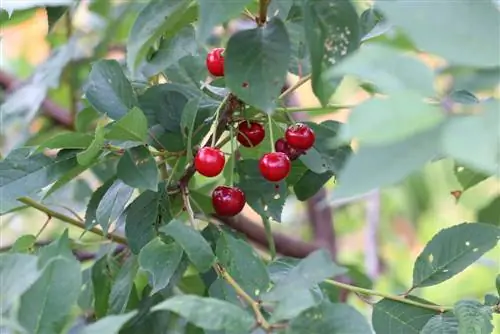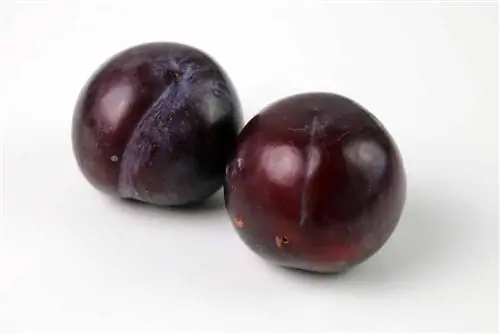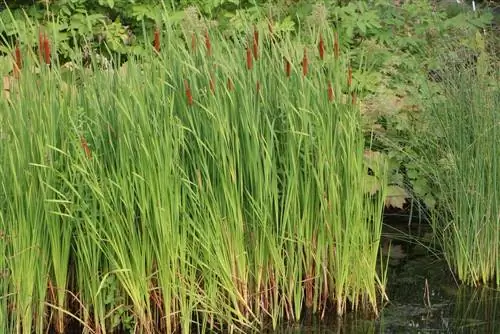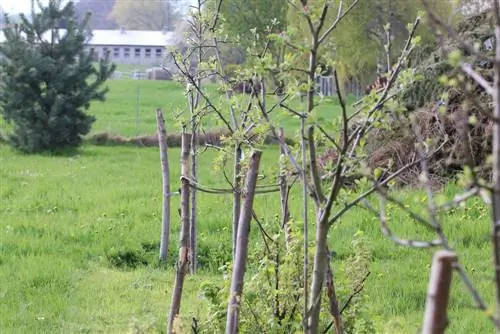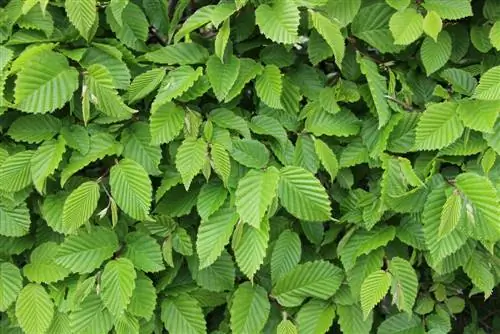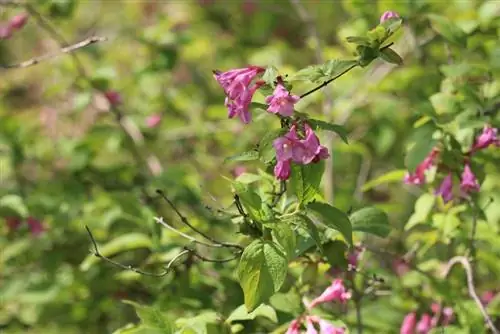- Author admin [email protected].
- Public 2023-12-17 03:39.
- Last modified 2025-06-01 06:48.
Caring for the cherry tree well can not only increase the chances of a rich yield, but also allows the plant to allow the fruits to ripen properly. However, there is often uncertainty among hobby gardeners when it comes to choosing the time for pruning cherry trees and the correct procedure. There is a great fear of damaging the tree by shortening it. However, with the right instructions and the right cutting tool, this important measure becomes child's play, even for beginners in plant care.
Cutting tools
Before you start cutting the cherry tree, you must have the right tools. The type depends on the amount of waste required. For a small, young cherry tree with thin shoots and branches, pruning shears are sufficient for a diameter of up to 1.5 centimeters. For more severe pruning, you should at least have pruning shears for thick branches and a hacksaw. Whatever the choice, the following points should always be taken into account:
- Keep blades sharp or use new saw blade to create straight and smooth cutting surfaces
- Disinfect cutting tools before and after use to avoid the transmission of germs and parasites
- It is better to use a tool with a large blade or strong power transmission than to have to apply multiple times or create uneven interfaces
If the cut surface is clean, smooth and even - instead of frayed and offset - it can dry faster and close more easily. Therefore, if possible, it is better to use pruning shears with a large diameter rather than small pruning shears that have to be used several times.
Tip:
Especially with a new garden, it is often tempting to buy all the cutting tools and utensils at once. This usually comes at the expense of quality. It is better to purchase the aids one after the other and even then it is better to purchase a few high-quality tools that are tailored to your actual needs rather than a large range of cheap tools.
Basic rules
When pruning the cherry tree, in addition to the cleanliness of the cutting tools, a few basic rules should be adhered to. These are:
- Cutting in the morning, in dry weather and sun, the cuts dry and close
- It's better to remove one large branch than numerous small ones
- wound protection should be applied to cuts larger than a 1 euro coin
- Better to cut a little annually than to cut back radically once every few years
- never cut a bare cherry tree
First cutting - plant cutting
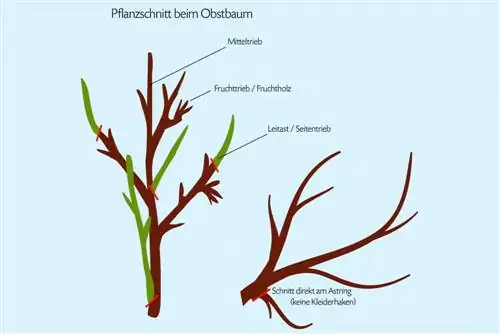
The first cutting of the cherry tree is done immediately after planting and serves on the one hand to form the tree and on the other hand to direct the use of energy. The young plant should not waste its strength on useless side shoots, but rather use them specifically.
This is what matters with this first plant cut:
- leave the main shoot standing - this is the extension of the trunk
- select three to five side shoots, which are cut back to a length of about six eyes
- all other shoots are removed up to the main trunk
In the case of the cherry, the so-called eyes are small dents from which shoots, leaves and buds will later sprout. These are still quite inconspicuous on young cherry trees, but are usually easy to see if you look closely. If in doubt, it is better to leave a little more length instead of radically shortening it right from the start.
Second care cut
The second care cut is carried out one year after planting. This will be:
- weak side shoots shortened by half
- strong branches cut by a third
- Inwards growing and crossing shoots removed
This care measure is primarily about preventing wild growth and thinning out the tree.
Time for care cuts
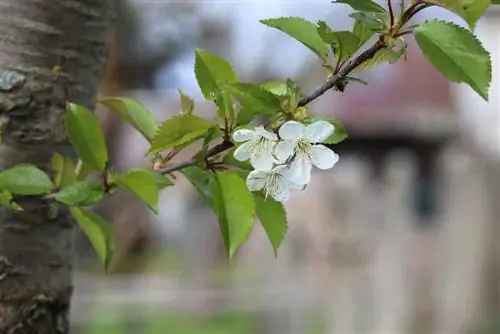
Both after the first two care cuts and for a previously uncut cherry tree, there is only one suitable time for the care measure: after the harvest. This makes the cherry tree an exception among fruit trees. As already mentioned, it should not be cut when it is bare, i.e. in autumn, winter or early spring. This has the advantage that dead, bare branches can be easily recognized. It also shows where branches are too close together. This makes targeted waste easier.
The following are again removed:
- crossing branches to thin out the crown
- Shooters growing towards the trunk
- the tips of the branches to keep the crown compact
Both thinning out and shortening the crown is very important for cherries, as the trees tend to go bald from the inside if sufficient light can no longer reach the trunk.
Radical waste
If a cherry tree has not been pruned for a long time and the crown now appears overgrown and too dense, you should wait until after the harvest or until late summer to carry out any care measures. Then you have to make a decision for the next few years. If the cherry tree is cut very heavily at once, the growth will be very strong next year.
However, only when it comes to the shoots, flowers and fruits will only appear sporadically. On the other hand, the waste can be rather gentle in the following years. However, if you prune carefully but carefully over several years, the yield will quickly return to high levels. For a more gentle radical cut, proceed as follows:
- stronger shoots and branches are shortened by a third
- weak shoots are cut back to half their length
- The main branches are gradually limited to four to six, but only one strong branch should be cut back to the trunk per year
- additional lighting is from top to bottom
With strong radical cutting, the number of branches is immediately reduced to the number mentioned and the thinning is also complete.
Tip:
To saw off strong branches, first saw about the first third or half from the bottom and only then from top to bottom. This prevents the bark from being torn out and larger wounds from occurring.
Sweet cherry

For sweet cherries, cutting can be done immediately after the harvest is complete. It is also important to ensure that the crown becomes very large and dense very quickly. This poses a high risk of baldness from within. This makes it all the more important to prune the sweet cherry tree from the start and annually. In addition, two special features should be taken into account:
- The so-called bouquet shoots are side shoots that together form a whorl shape
- they are particularly fertile and should therefore only be trimmed a little
- Water shoots grow steeply upwards parallel to the trunk and must always be removed
Sour cherry
Sour cherries may be blended immediately after harvest. However, the care measure can be waited a little longer, but it should not be carried out until autumn, as the tree's wounds will then heal more slowly and the risk of a fungal infection increases. There is also a significant difference with sour cherries that must be taken into account when blending - because there are varieties with annual fruit wood and perennial fruit wood. Varieties with annual fruiting wood, such as Morello Morelle, Gerema or Morelle Fire, bear fruit almost exclusively on annual shoots.
When cutting these cherry trees, care must be taken to ensure that older and slowly balding shoots are removed but that as many of the young branches as possible are retained. The situation is different with sour cherry, carnelian and sapphire, Dimitzer and Ludwigs Frühe - with these varieties the cherries thrive on perennial fruit wood and new shoots also branch out very well on old wood. The cut is therefore carried out as with sweet cherries by shortening the crown slightly all around and also thinning it out.
Conclusion
With the right knowledge about the variety and the requirements as well as regular maintenance, pruning a cherry tree is very easy, increases the yield and not only prevents the crown from balding from the inside out - but can also do that Reduce the risk of disease attacks because the plants are lighter and better ventilated.

